10 Stunning Dahlia Varieties to Grow in Your Garden
1. Cafe au Lait
This ethereal dahlia features large, dinner-plate sized blooms in creamy beige to pale pink tones. Cafe au Lait dahlias grow 3-4 feet tall and produce show-stopping 8-10 inch flowers that are perfect for cutting gardens and wedding bouquets. Plant these elegant beauties where they can be admired up close.
2. Thomas Edison
Named after the famous inventor, this dahlia produces deep purple, almost electric violet blooms that stand out dramatically in any garden setting. Growing to about 3 feet tall, Thomas Edison dahlias feature 6-8 inch formal decorative flowers with perfectly arranged petals that add sophistication to borders and containers.
3. Labyrinth
This striking dahlia showcases intricate, swirling petals in gradient shades of pink to salmon with subtle yellow centers. Labyrinth grows to approximately 3-4 feet tall and produces 4-6 inch blooms that create a mesmerizing visual effect. Its unique color variation makes it an excellent choice for garden focal points.
4. Bishop of Llandaff
Known for its striking dark foliage, this dahlia variety produces vibrant scarlet-red flowers that create a dramatic contrast against its deep purple-bronze leaves. Growing 2-3 feet tall, Bishop of Llandaff features 3-4 inch semi-double blooms that attract pollinators and add architectural interest to perennial beds.
5. Karma Choc
This chocolate-colored dahlia creates a sophisticated presence in the garden with its deep burgundy-brown blooms. Karma Choc grows to about 3 feet tall and produces perfectly formed 4-5 inch flowers with velvety petals. These sturdy plants make excellent cut flowers that can last up to a week in arrangements.
6. Arabian Night
This decorative dahlia features rich, velvety maroon blooms that appear almost black in certain light. Arabian Night reaches 3-4 feet tall and produces 4-5 inch flowers from midsummer until frost. Its dramatic coloration pairs beautifully with lighter flowers for striking garden contrast.
7. Akita
This impressive dinner plate dahlia produces massive 8-12 inch blooms in vibrant golden yellow with red tips. Akita grows 3-4 feet tall and creates a show-stopping display that demands attention in the garden. Its large, showy flowers need staking for support but reward you with spectacular blooms.
8. Kelvin Floodlight
This giant decorative dahlia produces enormous 10-12 inch bright yellow blooms that light up the garden. Kelvin Floodlight grows 3-4 feet tall and requires sturdy support for its impressive flowers. This variety is a consistent performer that delivers reliable blooms throughout the growing season.
9. Penhill Watermelon
This unique dahlia features large, fluffy blooms in a gorgeous watermelon pink shade. Penhill Watermelon grows 3-4 feet tall and produces 6-8 inch flowers with densely packed petals that create a lush, full appearance. Its pastel coloration brings a soft, romantic feel to garden borders and bouquets.
10. Diva
This cactus dahlia showcases spiky, pointed petals in a vivid magenta-purple that creates spectacular garden drama. Diva grows 3 feet tall and produces 5-6 inch star-like blooms that add texture and movement to flower beds. Its striking form and color make it a standout choice for modern garden designs.
Understanding Dahlia Classification Before You Plant
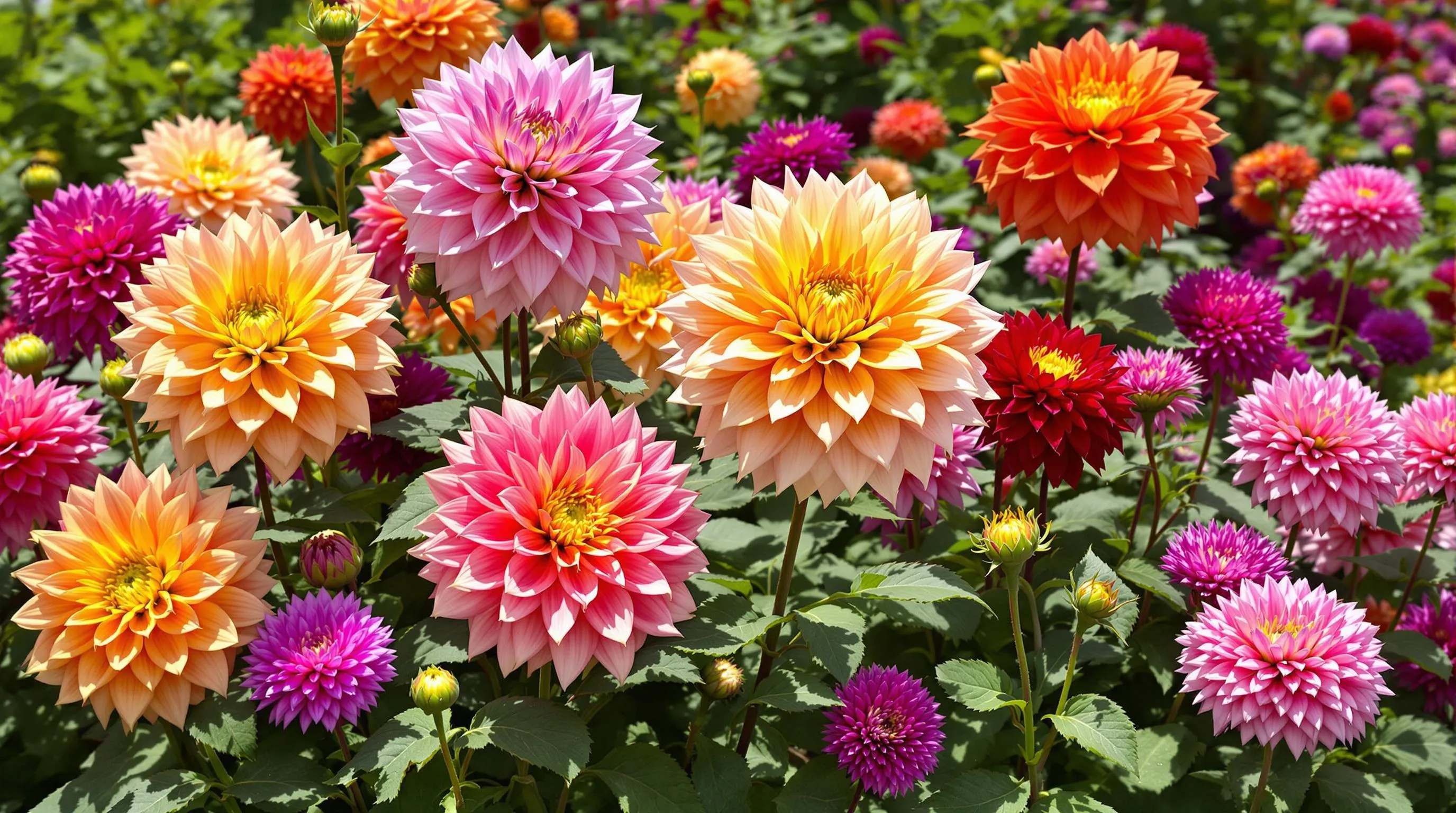
Before diving into your dahlia garden adventure, it’s essential to understand how these stunning flowers are classified. The American Dahlia Society has established a comprehensive classification system that helps gardeners select the perfect varieties for their exact needs and preferences.
Dahlia Size Categories Explained
Dahlias come in a remarkable range of sizes, from petite blooms to dinner-plate spectacles. The official size classifications include: AA or Giant (over 10 inches in diameter), A or Large (8-10 inches), B or Medium (6-8 inches), BB or Small-Medium (4-6 inches), M or Miniature (2-4 inches), and BA or Pompom/Ball (under 2 inches). Understanding these size categories helps you plan your garden space effectively, as larger varieties need more room and stronger support systems. The giant AA dahlias like ‘Kelvin Floodlight’ make stunning focal points, while miniatures and pompoms are perfect for containers or border plantings.
Flower Form Classification System
The diversity of dahlia forms is what makes this flower family truly special. The American Dahlia Society recognizes 14 different form classifications, each with distinct characteristics. These include Single, Anemone, Collarette, Waterlily, Decorative, Ball, Pompon, Cactus, Semi-Cactus, Laciniated, Peony, Orchid, Stellar, and Miscellaneous. ‘Cafe au Lait’ belongs to the Decorative class with its full, elegant blooms, while ‘Diva’ is a classic Cactus form with pointed, rolled petals. The Waterlily types like ‘Camano Messenger’ feature broad, slightly cupped petals arranged in a saucer shape. Ball and Pompon dahlias display perfect spherical blooms, and Singles show off open centers with a single row of petals. Knowing these forms helps you create diverse, visually interesting garden displays while selecting varieties that match your aesthetic vision.
Decorative Dahlias: The Classic Beauty for Any Garden
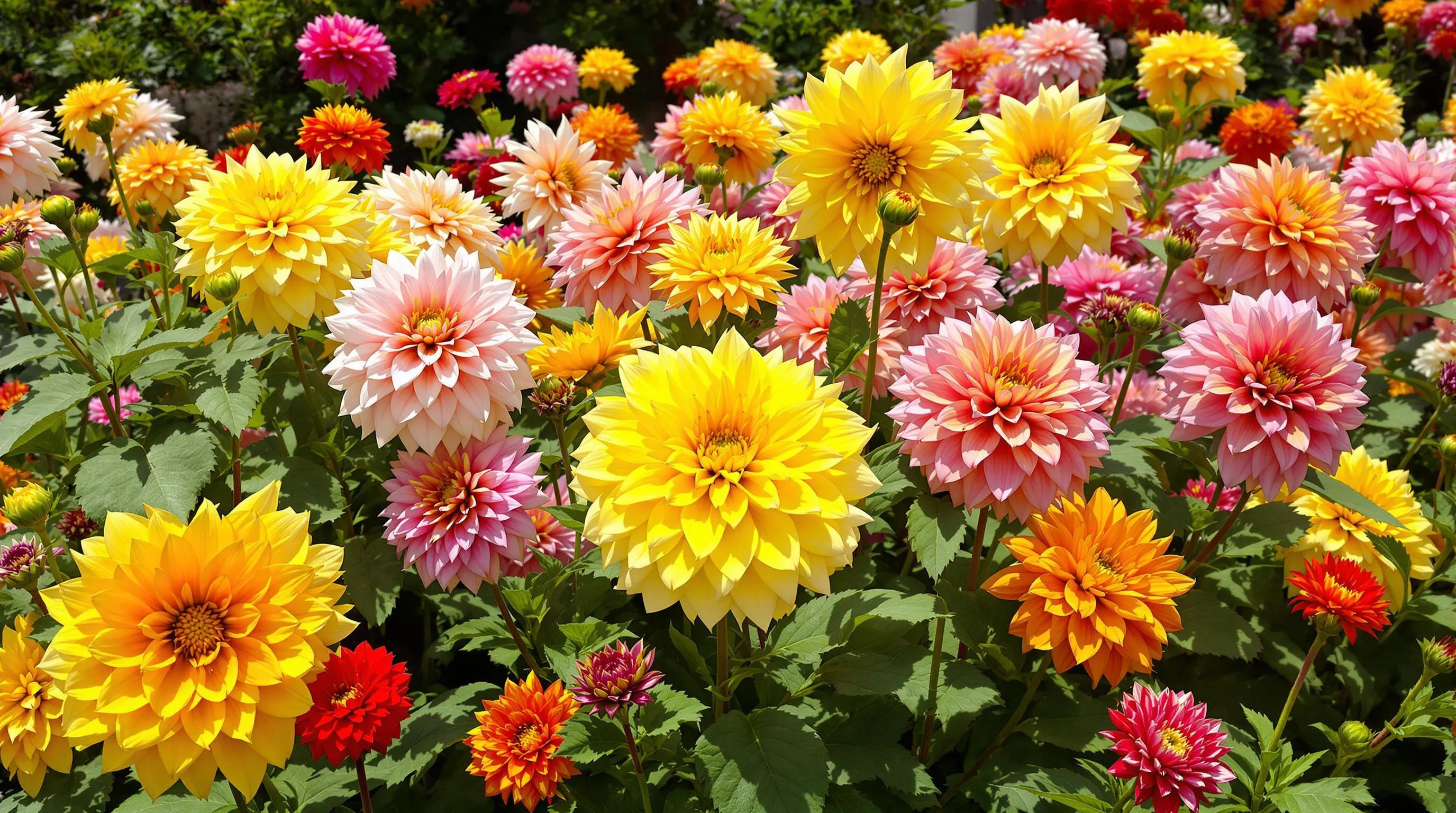
Decorative dahlias represent the quintessential dahlia form that most gardeners envision when thinking of these beloved flowers. With their fully double blooms featuring broad, flat petals arranged in a formal pattern, decorative dahlias offer a classic elegance that complements any garden design. These versatile beauties come in an extensive range of colors and sizes, making them perfect for both novice and experienced gardeners alike.
Large Decorative Varieties
Large decorative dahlias create dramatic focal points in your garden with their impressive blooms often reaching 8-10 inches in diameter. ‘Kelvin Floodlight’ stands out with massive, sunshine-yellow flowers that brighten any industry. ‘Otto’s Thrill’ delivers dinner-plate sized blooms in a soft pink hue that transitions to cream at the center, creating a romantic garden statement. ‘Crazy Love’ offers striking bi-colored petals in orange and yellow combinations that catch the eye from across the yard. These substantial varieties typically grow 3-5 feet tall, requiring staking for support, but reward your efforts with show-stopping blooms perfect for cutting and displaying in large arrangements.
Small Decorative Varieties
Small decorative dahlias pack all the charm of their larger cousins into more compact packages, making them ideal for container gardens or front-of-border plantings. ‘Little Robert’ produces abundant 3-4 inch vibrant red blooms on plants reaching just 24-30 inches tall. ‘Lilac Time’ enchants with its soft lavender flowers that bloom prolifically throughout the season. ‘Gallery Pablo’ offers cheerful orange-yellow blossoms on sturdy stems that rarely need staking, perfect for smaller garden spaces or patio containers. These more petite varieties typically bloom earlier and more abundantly than larger types, giving you an extended season of color while requiring less maintenance and support.
Ball and Pompon Dahlias: Perfect Spherical Blooms
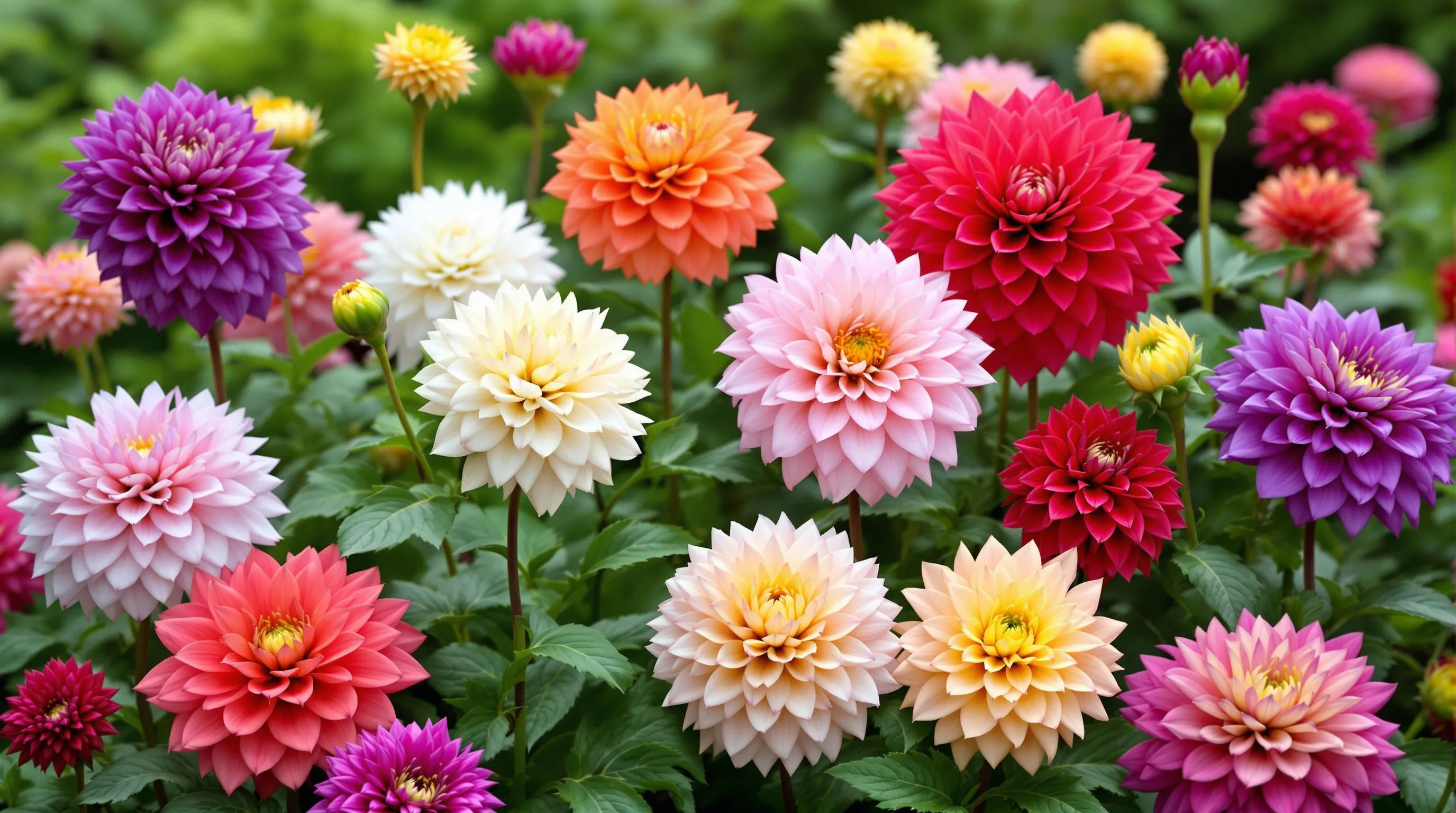
Ball and pompon dahlias stand out with their perfectly rounded blooms that resemble sculpted spheres. These varieties feature tightly packed petals arranged in a mathematical precision that creates a mesmerizing geometric display in your garden.
Ball Dahlia Varieties to Try
Ball dahlias showcase globe-shaped flowers typically measuring 3-4 inches in diameter. ‘Jowey Mirella’ delivers rich purple blooms that maintain their color throughout the season, making it a reliable performer in mixed borders. ‘Petra’s Wedding’ offers pristine white flowers with the slightest hint of green at the center, perfect for bridal bouquets and elegant garden displays. For a pop of color, try ‘Jowey Linda’ with its vibrant coral-orange perfectly formed blooms that stand out against green foliage. ‘Wizard of Oz’ captures attention with deep red spherical flowers that hold their shape even in rainy conditions, demonstrating the remarkable resilience of ball dahlias.
Pompon Dahlia Varieties for Cutting Gardens
Pompon dahlias feature smaller, more densely packed blooms under 2 inches in diameter that make exceptional cut flowers. ‘Little William’ produces perfect lavender-pink spheres on strong stems that last remarkably well in arrangements. ‘Tiny Treasure’ offers delightful butter-yellow pompons that bloom profusely from mid-summer through fall, providing continuous harvesting opportunities. ‘Franz Kafka’ stands out with its distinctive deep purple, almost black blooms that create dramatic contrast in bouquets. ‘Snoho Doris’ delivers perfect white pompons that complement any flower arrangement and dry beautifully for winter displays. These compact varieties typically produce more blooms per plant than larger dahlia types, making them exceptional value for cutting garden enthusiasts.
Cactus and Semi-Cactus Dahlias: Dramatic Spiky Petals
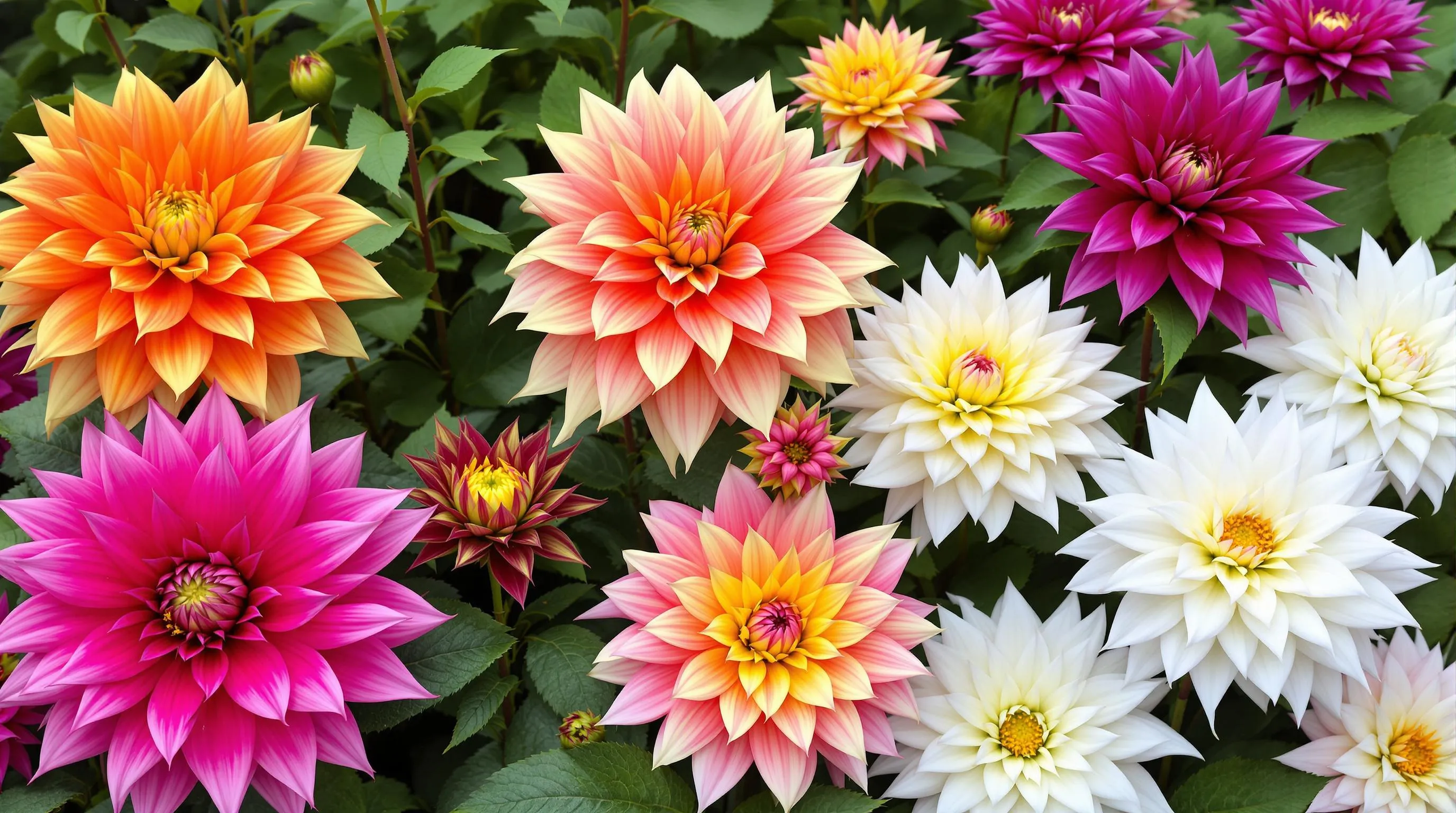
Cactus and semi-cactus dahlias stand out in any garden with their distinctive pointed petals that create an eye-catching, starlike appearance. These varieties feature narrow petals that roll backward for most of their length, giving them their characteristic spiky look that adds texture and drama to garden displays and floral arrangements.
Large Cactus Varieties for Impact
Large cactus dahlias create spectacular focal points in garden beds with their impressive size and intricate petal formation. ‘Neon Splendor’ dazzles with electric pink spiky blooms reaching 8-10 inches across, making it impossible to miss in any industry. ‘Hollyhill Spider Woman’ offers unusual two-toned orange and yellow flowers with extremely thin, twisted petals that truly embody the “spider” quality these dahlias are famous for. The stunning ‘Purple Gem’ produces rich violet blooms with perfectly pointed petals that create a starburst effect visible from across the garden. These varieties typically grow 4-5 feet tall, requiring staking for support, but reward your efforts with show-stopping blooms from midsummer until frost.
Semi-Cactus Varieties for Mixed Borders
Semi-cactus dahlias blend the dramatic spiky appearance of cactus types with slightly broader petals at the base, creating a more substantial bloom that holds up well in arrangements. ‘Karma Fuchsiana’ produces vibrant hot pink flowers with excellent vase life, making it a favorite among cut flower enthusiasts. ‘Tartan’ offers uniquely striped red and yellow blooms that add visual interest to mixed borders, while ‘Iceberg’ creates striking contrast with pure white pointed petals against dark foliage. These versatile varieties typically reach 3-4 feet tall and work beautifully alongside perennials like salvias and ornamental grasses, where their spiky form creates textural contrast. Their robust stems and slightly broader petals make them more wind-resistant than pure cactus varieties, offering reliability without sacrificing dramatic appeal.
Dinner Plate Dahlias: Show-Stopping Giant Blooms
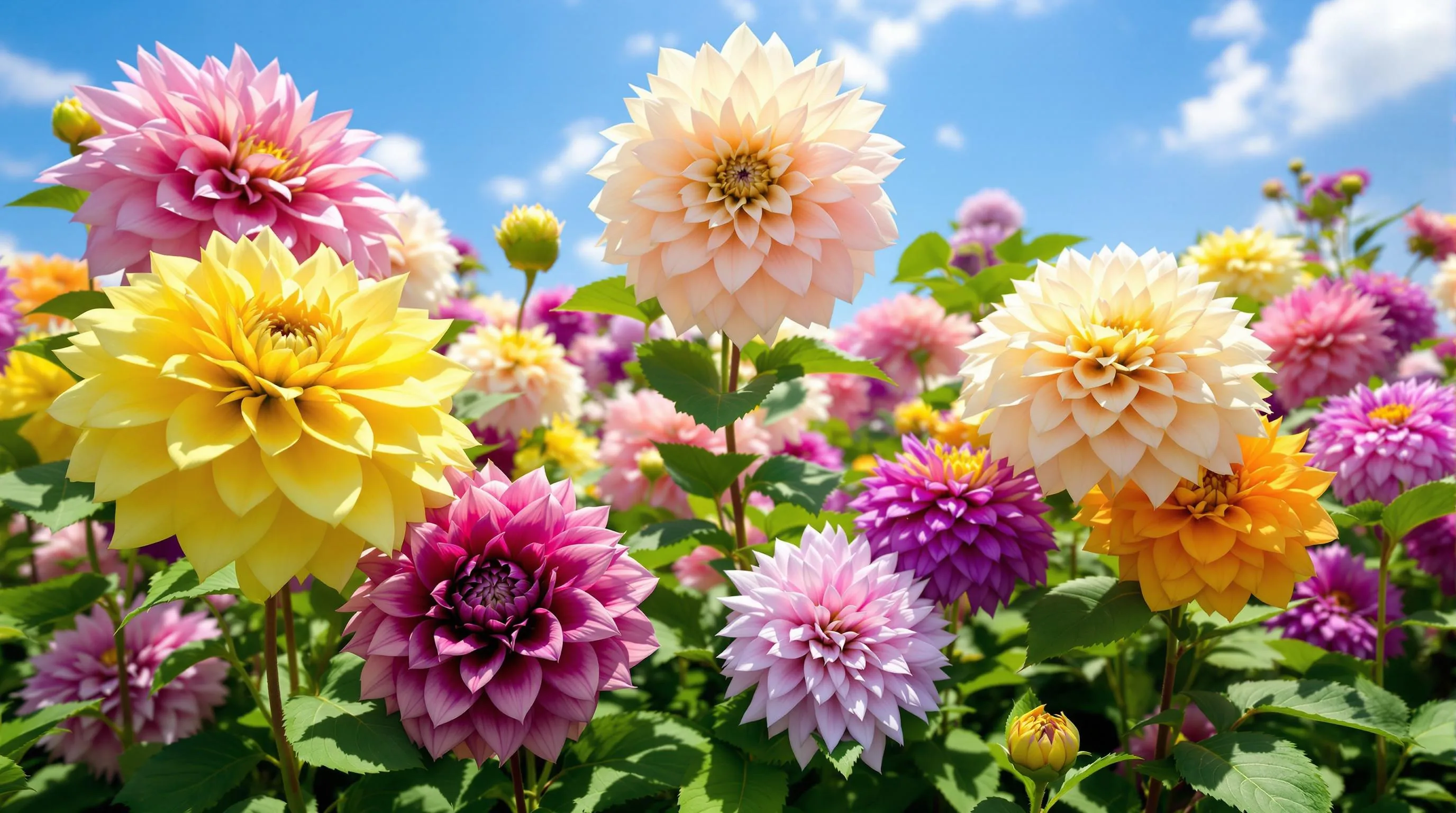
Dinner plate dahlias are the showstoppers of any garden, featuring enormous blooms that can reach up to 12 inches in diameter. These impressive giants belong to the AA (Giant) and A (Large) classification categories and create dramatic focal points wherever they’re planted.
Best Varieties for Maximum Size
‘Kelvin Floodlight’ reigns supreme among dinner plate dahlias with its massive 10-12 inch sunny yellow blooms that illuminate any garden space. ‘Cafe au Lait’ delivers on both size and elegance with its enormous creamy blooms featuring blush undertones that have made it a favorite for wedding arrangements. ‘Thomas Edison’ offers spectacular 8-10 inch deep purple flowers that provide rich contrast in garden designs. For truly impressive size, ‘Emory Paul’ produces massive deep pink blooms up to 14 inches across that command attention. ‘Penhill Watermelon’ features fluffy, soft pink petals creating dinner-plate-sized blooms with incredible depth and texture. ‘Otto’s Thrill’ delights with its giant peachy-pink decorative flowers that maintain excellent form even though their substantial size.
How to Support These Magnificent Flowers
Supporting dinner plate dahlias properly is essential due to their massive bloom size and top-heavy nature. Install sturdy stakes at planting time, reaching 5-6 feet tall and driven at least 12 inches into the ground to prevent disturbing developing tubers. Secure plants using soft garden twine tied in a figure-eight pattern to prevent stem damage as they grow. Consider implementing a grid support system with horizontal cross-wires for multiple plants in dedicated cutting gardens. Apply a 2-3 inch layer of mulch around plants to maintain consistent soil moisture and reduce weeds. Feed dinner plate dahlias with a low-nitrogen, high-phosphorus fertilizer (such as 5-10-10) every 3-4 weeks to promote larger blooms without excessive foliage growth. Disbud side buds regularly, removing smaller flower buds forming below the main terminal bud to direct energy toward producing those spectacular dinner-plate-sized blooms.
Waterlily Dahlias: Elegant and Refined Choices
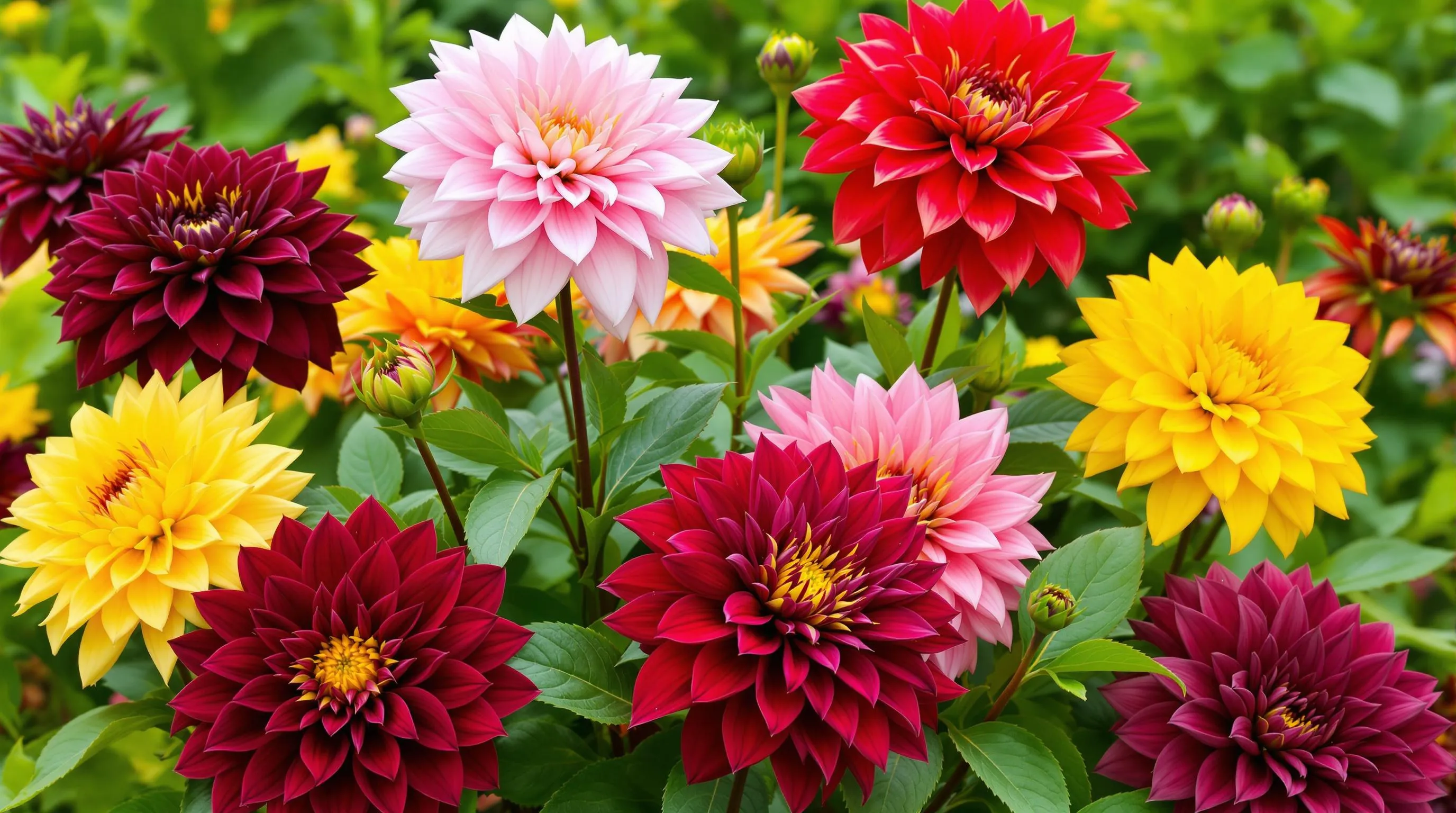
Waterlily dahlias showcase perfectly symmetrical blooms with broad, slightly cupped petals arranged in an elegant, circular pattern reminiscent of water lilies floating on a pond. Their refined appearance and moderate size make them favorites for both garden displays and floral arrangements.
Top Waterlily Varieties for Beginners
Waterlily dahlias offer exceptional beauty with relatively low maintenance requirements, making them perfect for novice growers. ‘Karma Naomi’ produces deep burgundy blooms with perfect symmetry that stand up well to summer heat. ‘Cameo’ delivers delicate pink petals with golden centers that transition beautifully from bud to fully open flower. ‘Glorie van Heemstede’ features bright yellow, perfectly formed blooms that add cheerful splashes of color to any garden. ‘Taratahi Ruby’ offers rich ruby-red flowers that maintain their vibrant color throughout the season without fading. ‘Chilson’s Pride’ produces soft pink blooms with excellent stem length, making it ideal for cutting gardens. These varieties typically reach 3-4 feet in height and bloom reliably from midsummer until frost, requiring only basic staking and regular deadheading to perform their best.
Complementary Planting Partners
Waterlily dahlias shine brightest when paired with complementary plants that enhance their elegant form. Ornamental grasses like ‘Karl Foerster’ feather reed grass provide a softening backdrop that highlights the structured blooms. Salvia ‘Black and Blue’ offers vertical contrast with deep blue flowers that accentuate pastel waterlily varieties. Verbena bonariensis creates an airy purple haze that floats above lower-growing companions while allowing dahlias to remain the stars. For seasonal interest, pair early-blooming waterlily dahlias with spring bulbs like tulips and daffodils, then transition to fall companions like sedum and asters. These thoughtful combinations extend your garden’s visual appeal while creating beneficial habitat diversity for pollinators attracted to your waterlily dahlias.
Collarette and Anemone Dahlias: Unique Central Patterns
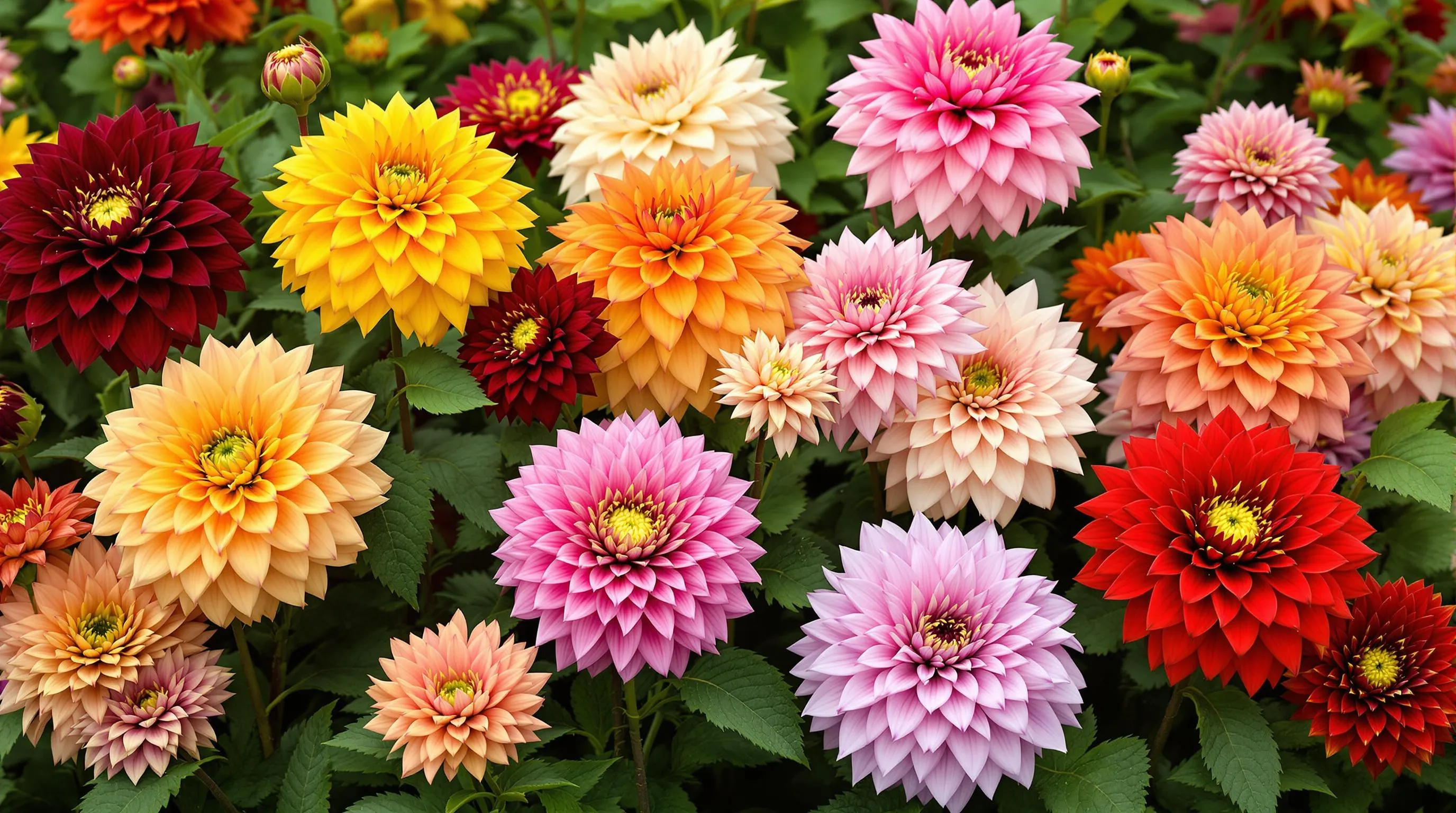
Collarette and anemone dahlias stand out in any garden with their distinctive central patterns that create visual interest beyond the typical dahlia form. Both types feature a unique arrangement of inner and outer petals that create depth and character, making them perfect for gardeners seeking something beyond conventional dahlia varieties.
Distinctive Collarette Varieties
Collarette dahlias showcase a single row of flat outer petals surrounding a collar of smaller, often differently colored inner petals, creating a striking two-tone effect. ‘Night Butterfly’ offers dramatic dark maroon outer petals with contrasting white inner petals, making it a standout in evening gardens. ‘Pooh’ delivers cheerful bright yellow blooms with orange collars that attract butterflies throughout the season. For striking color contrast, try ‘Apple Blossom’, which features soft pink outer petals with a crisp white collar. These varieties typically grow 24-36 inches tall and produce abundant 3-5 inch blooms perfect for cutting gardens. Collarette dahlias are exceptionally wind-resistant compared to more complex dahlia forms, making them practical choices for exposed garden locations.
Eye-Catching Anemone Types
Anemone dahlias feature a central cushion of tubular florets surrounded by one or more rings of flatter ray petals, creating a distinctly textured appearance. ‘Totally Tangerine’ produces vibrant orange blooms with darker central discs that provide excellent contrast in mixed borders. ‘Poppy’ delivers stunning scarlet-red flowers with prominent dark centers that resemble their namesake flower but with a longer blooming period. For a more subtle palette, ‘Nuance’ offers soft lavender petals surrounding a dense purple center that provides weeks of elegant blooms. These varieties typically reach 30-40 inches tall and produce flowers 3-4 inches across that hold exceptionally well in arrangements. Anemone dahlias are particularly attractive to beneficial insects due to their accessible central discs, making them valuable additions to pollinator-friendly gardens.
Single and Orchid Dahlias: Simple Yet Stunning Options

While many dahlia enthusiasts gravitate toward elaborate double blooms, single and orchid dahlias offer elegant simplicity that shouldn’t be overlooked. These varieties combine uncomplicated beauty with excellent garden performance, making them perfect for both beginners and experienced growers.
Pollinator-Friendly Single Varieties
Single dahlias feature one row of flat petals surrounding a central disc, creating a daisy-like appearance that’s irresistible to bees and butterflies. ‘Bishop’s Children’ stands out with its dramatic dark foliage and vibrant flowers in shades of scarlet, orange, and yellow. For a more dramatic look, try ‘Moonfire’ with its chocolate-colored leaves and bright orange-yellow blooms that create stunning contrast in borders. ‘Fascination’ offers rich magenta flowers against dark foliage, blooming prolifically from early summer until frost. These single varieties require minimal staking compared to their larger cousins and create pollinator-friendly zones in your garden while delivering abundant blooms for cutting.
Orchid Dahlias with Twist Appeal
Orchid dahlias elevate the single form with their distinctive rolled petals that create an elegant, twisted appearance reminiscent of their namesake flowers. ‘Honka’ varieties are among the most beloved, with ‘Honka Fragile’ featuring striking bicolor petals in white with vivid pink edges. ‘Knockout’ lives up to its name with brilliant scarlet petals that twist dramatically against the golden center. ‘Jowey Winnie’ offers sunset-orange petals that gracefully curve to create depth and movement in arrangements. These open-centered blooms allow easy access for pollinators while their distinctive petal formation creates artistic silhouettes in the garden. Orchid dahlias typically reach 3-4 feet tall and perform exceptionally well in mixed borders or dedicated cutting gardens where their unique form can be appreciated up close.
Growing Tips for Success with All Dahlia Varieties
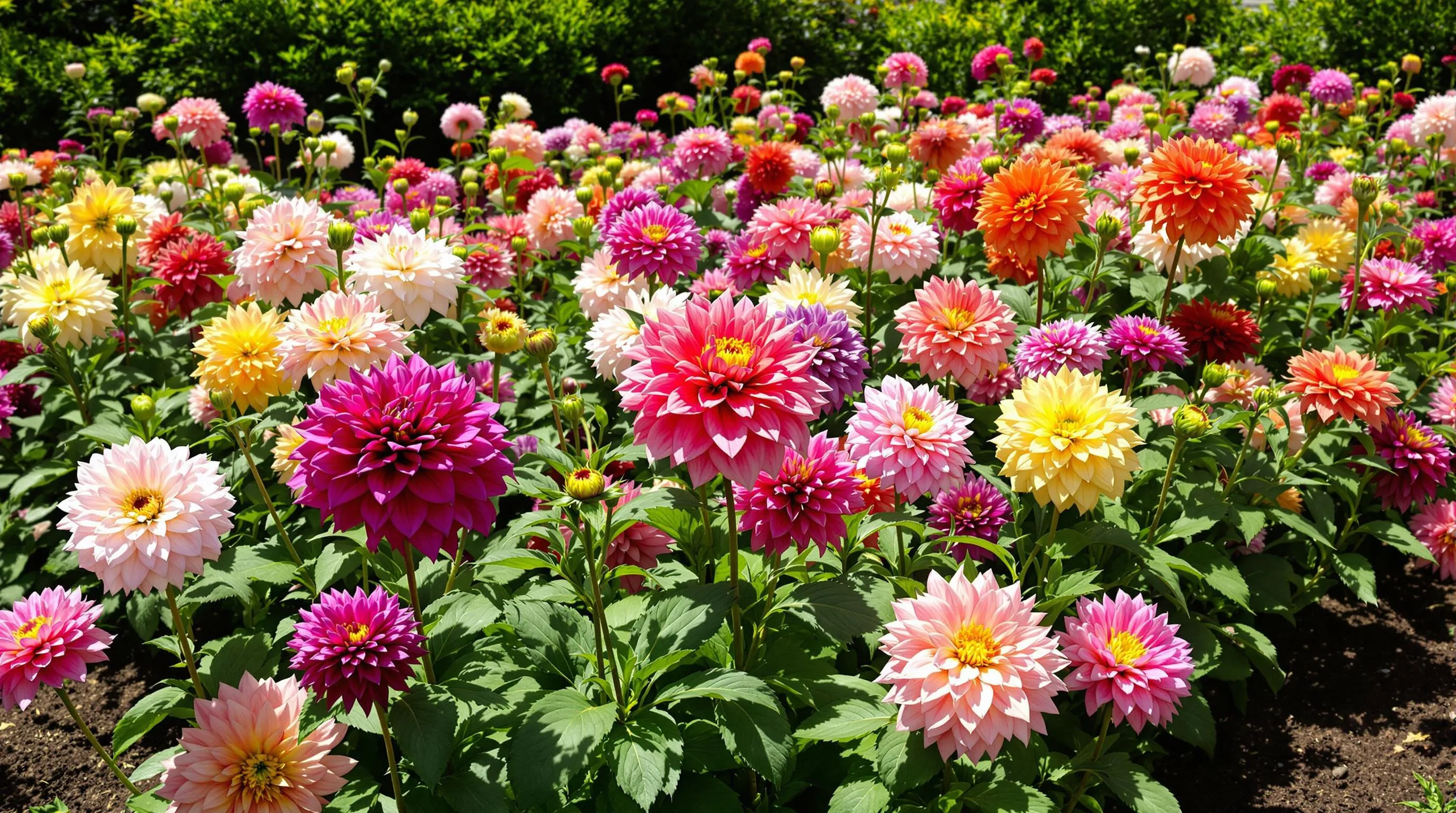
Achieving spectacular blooms from your dahlias requires attention to their basic needs and growing conditions. Whether you’re cultivating dinner plate varieties or dainty pompons, these fundamental practices will help ensure vibrant, healthy plants throughout the growing season.
Planting and Care Essentials
Plant dahlias after all danger of frost has passed when soil temperatures reach at least 60°F. Choose a sunny location that receives 6-8 hours of direct sunlight daily for optimal flower production. Prepare the soil by incorporating compost or well-rotted manure to improve drainage and fertility. Plant tubers 4-6 inches deep with the eye (growth point) facing upward, spacing them 18-24 inches apart for smaller varieties and up to 3 feet apart for larger types. Water thoroughly after planting but avoid overwatering until sprouts emerge to prevent tuber rot. Once established, provide deep watering 2-3 times weekly rather than frequent shallow irrigation. Apply a low-nitrogen, high-phosphorus fertilizer (such as 5-10-10) monthly to encourage abundant blooms. Support taller varieties with stakes installed at planting time to prevent damage from winds or heavy blooms. Pinch growing tips when plants reach 12-18 inches tall to promote bushier growth and more flowers. Deadhead spent blooms regularly to extend the flowering period well into fall.
Pest and Disease Management
Monitor your dahlias regularly for common pests like aphids, thrips, and spider mites, which can be controlled with insecticidal soap or neem oil applications. Slugs and snails often damage young growth, so apply organic slug baits or create beer traps around plants. Prevent powdery mildew by ensuring good air circulation between plants and avoiding overhead watering. For plants showing signs of infection, apply a fungicide labeled for ornamentals. Watch for viral diseases, which typically manifest as stunted growth or mottled foliage—remove and destroy affected plants immediately to prevent spread. Combat stem rot by ensuring proper drainage and avoiding excess moisture around the crown. Earwigs can damage buds and flowers; trap them with rolled newspaper tubes placed near plants overnight. Store tubers properly during winter by cleaning off soil, drying thoroughly, and placing in containers with slightly damp peat moss or vermiculite in a cool (40-50°F), dark location. Inspect stored tubers monthly for signs of rot or desiccation, discarding any that show disease symptoms to protect your healthy stock for next season’s planting.
Conclusion: Selecting the Perfect Dahlia Varieties for Your Space
From elegant waterlily forms to dramatic dinner plates and spiky cactus types you’ve now discovered the incredible diversity dahlias offer. Whether you’re drawn to the classic beauty of decorative varieties or the perfect spheres of ball and pompon types there’s a dahlia that fits your garden vision.
Remember that understanding size classifications and flower forms helps you select varieties that will thrive in your exact garden conditions. Start with just a few types that catch your eye then expand your collection as you gain experience.
With proper planting timing adequate support and consistent care you’ll enjoy a spectacular display of these versatile bloomers from midsummer until frost. Your dahlia journey is just beginning – get ready for a lifetime of colorful rewards!





